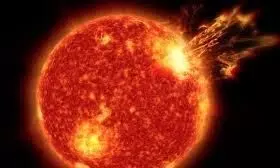
Powerful X-class solar flare erupts, geomagnetic storms set to light up skies
text_fieldsIntense solar activity this week has led to the eruption of a powerful X1.3-class solar flare on Thursday.
The flare, which originated from an unnumbered sunspot, occurred at 5:43 AM EDT (9:43 UTC) and briefly disrupted high-frequency radio communications across Africa, Europe, and parts of Asia, according to the National Oceanic and Atmospheric Administration (NOAA).
X-class solar flares are the most powerful of their kind and are known to cause radio blackouts in sunlit areas of Earth.
This eruption follows a series of strong solar flares earlier in the week, including M-class flares from sunspots AR 3811 and AR 3814. As a result of these events, a geomagnetic storm hit Earth on September 12, rated G3 on NOAA’s five-level scale. The storm was triggered by a coronal mass ejection (CME) launched by a previous solar flare on September 10.
When CMEs reach Earth, they interact with our planet's magnetic field, often leading to geomagnetic storms that produce stunning aurora displays in the Northern Hemisphere. Many areas in the western United States reported visible auroras following the storm.
This will likely lead to even more vibrant auroras in higher-latitude regions of the United States. Scientists continue to monitor the sun's activity to track potential disruptions and forecast future aurora displays.






















